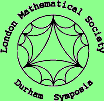 |
|
| Home | |
| Programme | |
| Short Courses | |
| Talks | |
| Posters | |
| For Presenters | |
| Participants | |
| Travel | |
| Recreation |
LMS Durham Symposium
Computational methods for wave propagation in direct scattering
Thomas Hagstrom (New Mexico. USA)
New results on absorbing layers and radiation boundary conditions
Abstract
A fundamental difficulty in the computational time-domain analysis of scattering problems is the accurate truncation of the unbounded physical domain. After years of having no satisfactory techniques, there are now at least five methods available for the classical problems wave equation, Maxwell's equations which can provide arbitrary accuracy at acceptable cost. These include high-order spatially local and nonlocal complex exponential approximations to convolution kernels, methods exploiting Huygens' principle, fast evaluation of the retarded potential, and reflectionless absorbing layers or PMLs. We will compare and contrast these methods, hoping to help the practitioner to make an informed decision. Our focus is on:
- The basic description of the methods - how they work, when they work, and what is required to use them.
- Their basic numerical analysis, in particular the computational requirements to attain a given accuracy.
- Extensions to more general hyperbolic systems e.g. the compressible Euler equations, nonhomogeneous media, and the Schrödinger equation.